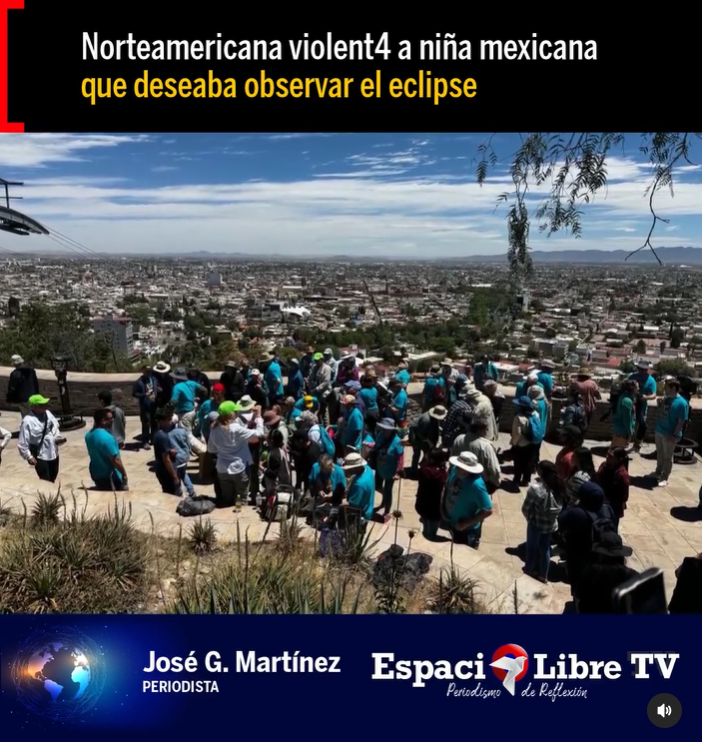American Tourists Aggressively Stop Locals in Durango, Mexico from Watching Eclipse in Public Space

On April 8, many in parts of the United States and Mexico were gearing up to watch the total solar eclipse. In the city of Durango, Mexico, residents were particularly excited because they would enjoy the most visibility of this rare phenomenon. People gathered in public spaces, including one of the most popular spots, the lookout of “El Cerro de los Remedios,” which offers panoramic views of the city. However, residents’ excitement turned sour when a group of U.S. tourists claimed to have rented the entire front area of the public space, keeping everyone else from accessing prime area with the best vantage point.

As reported by Espacio Libre, a local news and media website that planned on transmitting the eclipse, some of the U.S. tourists were blatantly disrespectful toward locals, claiming that they were having a “private event.” The tourist group was accompanied by the assistant secretary of “Planificación y Desarrollo Turístico” (“Tourism Planning and Development”), Olivia Margarita Fernández, who was seemingly involved with the U.S.-based travel agency, “Betchart Expeditions.” Fernández supported the group of what seemed to be mostly American tourists by claiming that the area was only accessible to those who had paid to be there. When asked who they paid, she provided no answer.

As reporter José G. Martínez and his cameraman asserted their right to be there; they were met by the entitled attitude of one of the women from the tourist group, later identified as tour guide Tanya Deyoung. In the video shared by Espacio Libre, Deyoung is seen mockingly saying “goodbye” and “adiós, ahora” as she waves them away dismissively. When Martínez refused to leave, she yelled “no” in his face and physically blocked him from entering the area that the foreigners appropriated as theirs.

As the confrontation continued, Deyoung claimed that the tourist group had a “contract” with Fernández for the private use of the space. Martínez and his cameraman didn’t back down, and neither did the residents, who also started to speak up. Among them was a young girl who defended her right to be there. She said, “They won’t let us in, they’re blocking us. They’re not respecting the rules. We have priority because we live here. When we go there [to the U.S.], they kick us out. They’re acting as if this is their city.”

Before the girl could continue, Deyoung interrupted and silenced her, screaming very close to her face, “Please leave our private event!” Then, she continued mockingly saying “adiós” and waving them away.

Eventually, Martínez approached assistant secretary Fernández, asking to see the alleged permit that allowed the foreigners to claim a public space. Espacio Libre was shown a document that turned out to be a request, not a permit. The request was addressed to the Director of “Ferias, Espectáculos y Paseos Turísticos de Durango” (“Fairs, Shows and Sightseeing Tours of Durango”), asking for the space to set up a group of “specialists in various fields to observe the eclipse” from 8 a.m. to 3 p.m.
Martínez noted that the group didn’t have any specialized equipment with them, and the request didn’t specify what kind of specialists they were. Moreover, they were seen dancing, led by Fernández, an activity usually practiced for entertainment, not scientific observation.


Espacio Libre’s investigation revealed that they weren’t a group of specialists at all and that the travel agency charged 6,390 USD per person. There were at least 50 people in the group, according to Martínez, which adds up to around 319,500 USD or 5,400,000 MXN. Martínez wondered how much of that money was pocketed by the government of Durango to allow the group of foreigners to appropriate the most privileged spot to watch the solar eclipse.

When Espacio Libre shared clips of these deplorable actions on social media, Durango residents and people all over Mexico and the U.S. were outraged. The video quickly went viral as more and more Latinos reproached the vile attitude of white Americans, who, even in foreign countries, feel entitled to claim any space as theirs. Moreover, many took to Yelp to leave scathing reviews calling out the racist behavior of Betchart Expeditions’ staff. Currently, the travel agency's website and Facebook page are temporarily down.
It’s speculated that the Department of Tourism Planning and Development carries some of the responsibility by allowing Fernández to rent out a public space. It’s not just illegal to do so, but it also violates an essential human right–the freedom of movement. In response to the allegations, the Department of Fairs, Shows and Sightseeing Tours of Durango issued a statement, claiming, “At no time was space rented to foreign tourists at this sighting point. Only a small space was delimited to protect the technological equipment of foreign astronomers."
Many perceive these actions as discriminatory against Mexicans, and the fact that it happened on their own soil, seemingly backed by their own government, makes the situation even more shocking. Below is the full video from Espacio Libre TV on Instagram for the complete story.
Note: the video is in Spanish, no English captions are available on Instagram.











